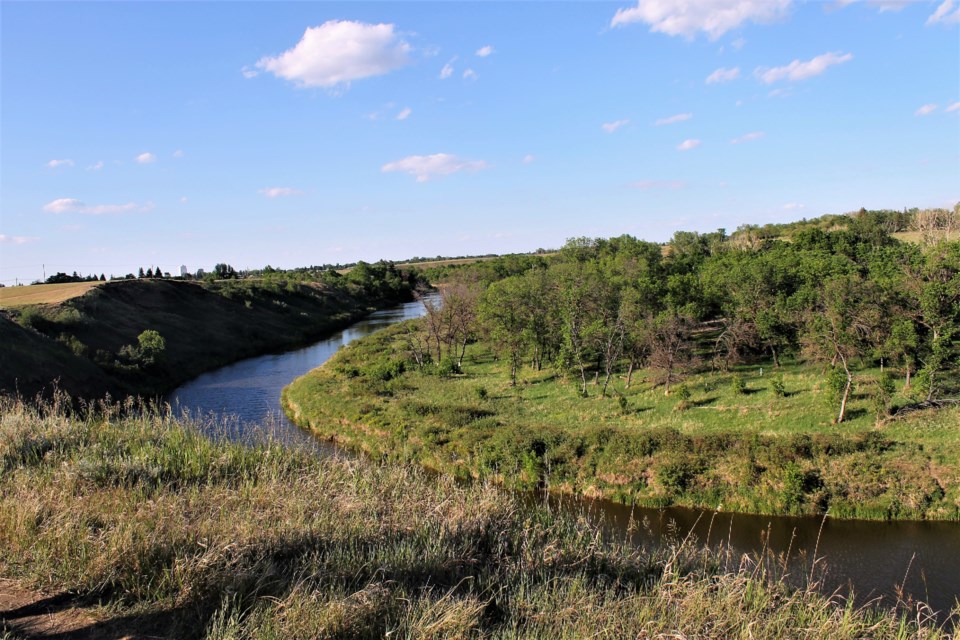As part of the week-long celebration of Aboriginal culture, the Wakamow Aboriginal Community Association organized an idyllic walking tour down into Tatawâw Park on June 18, to experience the area where the Lakota camped for several decades.
Chief Black Bull and his band traveled to the Moose Jaw area in 1833, and made what is now Tatawâw Park their permanent home for 30 years, until the reserve land at Wood Mountain was solidified in the early 1910s.
In the next few years, the Lakota people dispersed from the camp; many went to the Wood Mountain reserve, some scattered to other places, and some lingered. By 1913, the Lakota were completely relocated.
But the land they lived on remains, with the river and the hills that bordered the main camp intact. The years that the area spent as the Wild Animal Park zoo have left an imprint — sections of concrete, planted trees, and the two bridges — but is still relatively untouched.
Historical author Ron Papandrea finds the area fascinating, as he has spent a lot of time researching the Lakota and the defeat of General Custer at the Battle of the Little Bighorn in 1876, during The Great Sioux War.
Sitting Bull, who was elected by the chiefs, led the Lakota Sioux in the clash dubbed Custer’s Last Stand, and his is the name most people are familiar with related to that historical moment.
But that defeat has ties to the Lakota who settled near Moose Jaw, as Black Bull — who took part in that battle and was wounded in the leg — was one of two very prominent chiefs who settled in Canada following the victory.
“All people know about is Sitting Bull and they don't want to acknowledge that there are other chiefs that were very important,” said Papandrea. “Black Bull was an important chief, but he gets drowned out by Sitting Bull.”
During the walk, Papandrea provided extensive history about the Lakota and Black Bull — who in 1895, sponsored the only Ghost Dance known to have taken place in Canada, after friend and successor Brave Heart brought knowledge of the ceremony with him from America.
The grave of Black Bull’s wife, Tasinaskawin Brule, was recently honored with a re-dedication from members of the Black Bull family.
Rich Pickering, who worked in the Wild Animal Park for many years, joined Papandrea in leading the tour, as he has extensive knowledge of the park’s terrain.
Based on photographs, and taking into account the natural shifting of topography, Pickering is sure that the Lakota camped in the valley near the 9th Ave SW entrance to the park — in the flat area just over the bridge, between the river and the hills to the east.
The low land had easy access to water and was protected; during times of flooding, the camp could be moved up the ridge into higher land. Although the river curves around the valley, the natural river crossing wasn’t too far away — further south, near what is now Connor Park.
The choice to settle here made it possible for the Lakota to live a more traditional roaming and hunting lifestyle for 30 years longer than those in America. Their proximity to Moose Jaw also allowed them the ability to work and trade in the town.
It was a poignant moment for Clayton Getz Smoker, who sits on the WACA board, to stand on the piece of land that so many Lakota inhabited over 100 years ago.
“You can close your eyes and just imagine the elders standing on the hill over there,” said Smoker. “We used to live here, this is our home, and it's beautiful.”
He was glad to see people come down for the historical tour and is proud of the events going on during the week leading up to National Indigenous Peoples’ Day.
“This is the first Aboriginal Week, and it's a big success, and I hope it goes on for years and years,” said Smoker.




